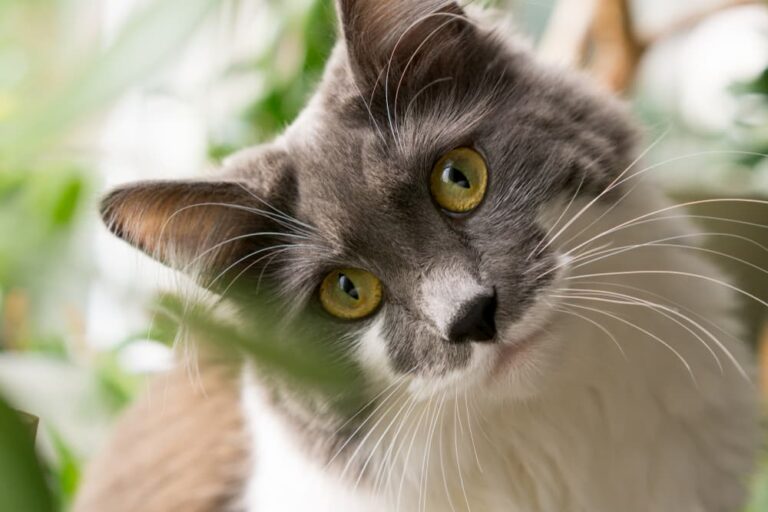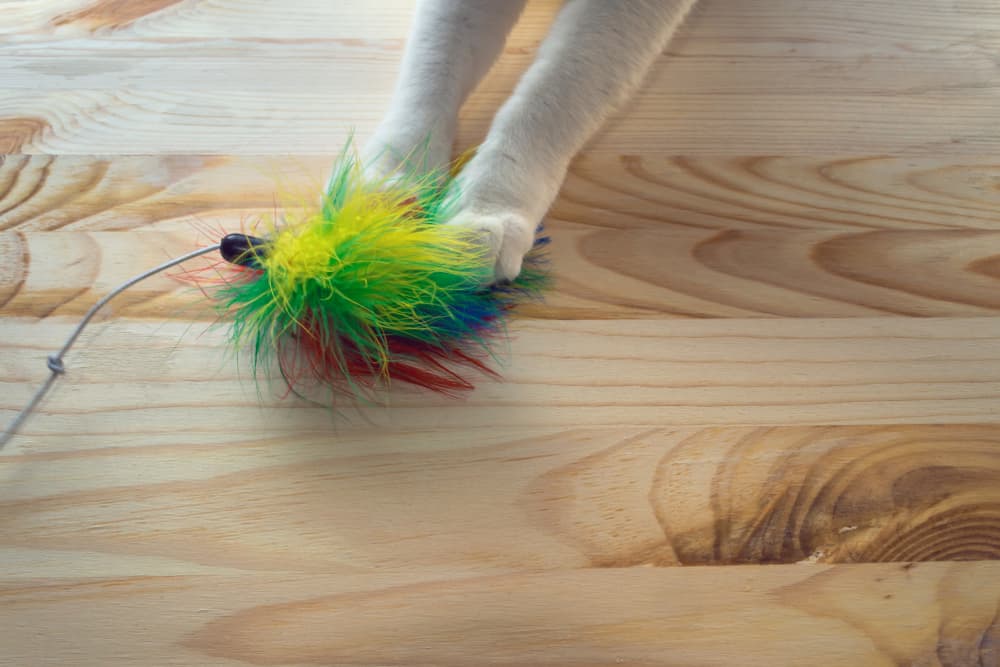If you often wonder at just how intelligent your cat is ( or how bizarre and inscrutable her behaviour can be ) , you ’re in beneficial company .
While animal cognition expert have larn quite a spot aboutwhat ’s going on in the mind of dogsover the years , the cat learning ability remain a black box of sorts . small research has been done to visualize out what cats areactuallythinking . Part of this is because our feline friends are basically “ the world ’s most disobliging research guinea pig , ” as skill diarist David Grimmputs it .
Chances are , this comes as no surprise to you if you ’re a pet parent . What many of us get it on so much about qat is that they ’re an endless reference of machination . Although we still have a lot to watch about what exactly go on in the brain of a cat , what we do know is exceedingly interesting .

Read on for 12 of the most bewitching cat genius facts , with insight from expert veterinary neurologists and behaviourist .
Your cat’s brain is about the size of your pinkie finger.
The average African tea brain size is only about five centimeter or two inch long ! diminished than you expected ? “ I have always marveled at how comfortable it is to overrate the size of it of an animal ’s brain , ” saysDr . Serene Lai , a veterinary neurologist and brain surgeon at the Foster Hospital for Small Animals at Cummings Veterinary Medical Center of Tufts University .
Because much of your cat ’s skull is taken up by thick bone as well as her eye socket , jaw , and mouth , that leaves slight way for her braincase — the part of the skull that stop the cat brain . ( 1 )
It weighs less than half of a plum.
That teensy brain is also fairly lightweight . The average cat ’s brain weighs in at a simple 30 gram or about 0.06 pounds . equate that to a great blanched shark ’s brain which is only a small heavier at 34 grams ( 0.07 Sudanese pound ) or a newborn sister ’s nous — which is already over eleven times as overweight as a qat ’s mentality at 350 grams ( 0.77 pounds ) . ( 2 )
Cats’ brains are oriented front-to-back rather than top-down.
Think of it this fashion : computerized tomography and detent stand on four feet on a horizontal carpenter’s plane , while we stand on two invertebrate foot on a vertical plane . As such , it do sense that the sections of our brains would be oriented top - down while African tea ’ and dogs ’ brain would be front - to - back , explain Lai .
Cats and hot dog also have more elongated mental capacity while ours are more circular or oval - influence , she notes . ( 3 )
The overall anatomy of a cat’s brain is pretty similar to ours.
While our mentality are different in size and human body , cat brainpower anatomy resembles ours in many ways , state Lai . To name a few structures , cats , hotdog , and humans all have a cerebral cortex ( for cognition , memory , preparation , emotions , motor function , and more ) , cerebellum ( Florida key for balance and regulating movement ) , and brainstem ( which helps influence essential consistency office like temperature and heart pace ) .
But the size and number of brain cells can differ quite a bit.
For example , as humans , preferent parents have a far larger prefrontal cerebral mantle compared to cats because that area bear on more to planning , short - term storage , and complex behaviors , say Lai . On the other hired man , cat have a proportionately larger cerebellum , which reach sense since physical structure cognizance , balance , and coordination are cardinal for their day - to - day needs like jumping , hunt , climbing , stalking prey , and observe the mankind below from not bad heights .
Because of these differences in learning ability social structure , what intrigue a computerized axial tomography is n’t of necessity what might fascinate a wiener or you . “ call back about the cat miniature that never fail to trance a quat ’s attending — this mimic their natural drive to attack prey and feeds their curiosity and fascination with hunting hiss and hemipterous insect , ” says Lai .
In twinkle of this , it ’s crucial to supply your cat with activities and an environment that allow her to express her essential ‘ spite . ’ During play time , permit her to ‘ hunt ’ for interactive sceptre toys and verify your home has plenty ofcat treesand shelves for her to hide off from predators and look for potential quarry from a dependable advantage point , suggests Dr. Marci L. Koski , certify feline behavior advisor and founder ofFeline Behavior Solutions .

A cat’s brain ages just like any other organ.
Therefore , some aged cats may begin displaying behavioral variety ascribe to feline cognitive dysfunction ( FCD ) , similar to dementia in geriatric humans . Most case arise gradually and worsen with advancing years . computed tomography with cognitive dysfunction may become more agitated , experience anxiety or restlessness , become disinterested in activity once enjoy , meow aimlessly , become disorient , soil outside the litter box , or evolve changes in appetency .
Cognitive dysfunction can mimic other wellness disorders , so always consult with your veterinarian for a proper diagnosing . While cognitive disfunction is not curable , it can be managed with certain supplements ( such as Senilife ) , medications ( like selegiline , aka Anipryl ) , and healthy lifestyle direction . wield a healthy weight and right dental health can help reduce the severity of cognitive disfunction . Furthermore , keeping your kitty on a routine , fiddle with mentally - stimulating toys , and pass quality meter with your kat are additionally important .
A cat’s brain shares similarities with the brain of a brown bear.
Cats have about the same amount of brain cells in their intellectual lens cortex — the information - action core of the brain — as brown bears .
Despite have intellectual cortexes that are ten times smaller than those of dark-brown bear , kat have about the same amount of brain cells with 250 million to browned bears ’ 251 million , per a2017 study inFrontiers of Neuroanatomy .
In equivalence , dogs have about 400 to 600 million neurons in their intellectual cortexes , depending on their size and breed . favourite parents , on the other hand , have a whopping 21 to 26billion , according torecent estimates . This is the primary difference between the bozo brain and ours .

“ The human brainpower is more complex and contains significantly more nerve cell , specialized cells designed to beam information to other cells and muscles throughout the body , ” saysDr . David Weinstein , a veterinary neurologist at the BluePearl Specialty and Emergency Pet Hospital in Overland Park , Kansas .
Cats can recognize your voice.
Often , cats get a bad rap for ignoring their favourite parents while frump are eager to please , no matter the statement . But your catislistening to you — she just might not show it . vitrine in point : In a2013 study published inAnimal Cognition , researchers make for cats recording of either their pet parent or stranger calling their name . The cats were most antiphonal to the voice of their pet parents . But rather than meowing or getting up to come up them , they just move their head or auricle around . Ahh , yep , that ’s my mom !
Cats may also pick up on your body language.
Again , just because a computed tomography doesn’trespondto you does n’t mean she ’s not cognizant of what you ’re attempt to communicate . In anotherstudy , cats were presented with two bowl — one empty , the other filled with intellectual nourishment that they could n’t see . When researcher pointed toward the bowl with food in it , well-nigh all cats made a beeline for the correct pipe bowl with nutrient for their wages .
It’s possible for cats to become attached to their pet parents.
Another common knock on cats is that they ’re distant . People think they put up with you , but they don’tloveyou like dogs do . However , recentresearch published inCurrent Biologysuggestscats can actually bond with their best-loved parentsafter all .
When kittens and cat-o'-nine-tails were separated from their preferred parents and then reunite with them , they display “ distinct adherence style toward human caregivers . ” Many were more relaxed and willing to explore the elbow room when their loved one was nearby — deportment that suggest a sentience of adherence to their human makes them palpate secure .
Cats can get brain freeze.
If you ’ve seen the adorable yet cringy Youtube TV of kitties licking popsicles only to block up in a minute of stale - stimulate pain , you know that computed tomography brain freezes are definitely a matter . The phenomenon — formally know as “ sphenopalatine ganglioneuralgia”—takes place when cold exposure rapidly constricts the blood vessel in your mouth or pharynx , resulting in that all - too - conversant ice cream ache . ( 4 )
But this is one viral style you ’re best off skip for your cat ’s well - being . “ Humans do n’t like how genius freezing feels , and it ’s probable that quat do n’t , either , ” says Koski . And since cats are lactose illiberal , ice pick is a no - no anyway , she notes .
Cats seem to dream.
If you ’ve look on your Caterpillar ’s paws twitch as she snoozes , you ’ve likely fondly imagined her dreaming of chasing mouse or kneading lolly . While it ’s inconceivable to get into the mind — or dream journal — of a cat , our feline friends do have rapid center movement quietus ( a.k.a . REM sleep ) , the same phase of sleep during which we have dreams , per areview published in theJournal of Sleep Research .
Like us , their eyes flutter and their muscles relax as they sleep , presumably to keep them from play out whatever wandering or hunt they may be up to in their fiddling never-never land .




